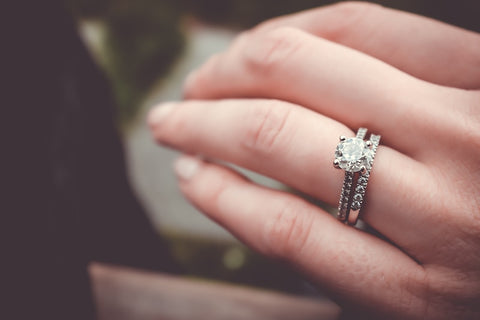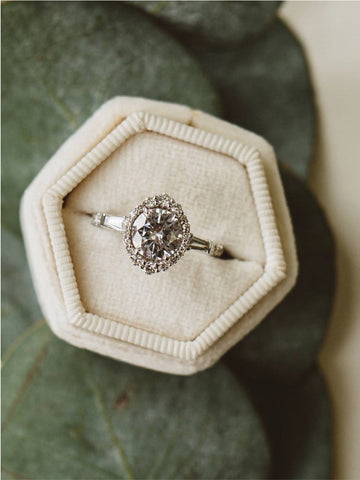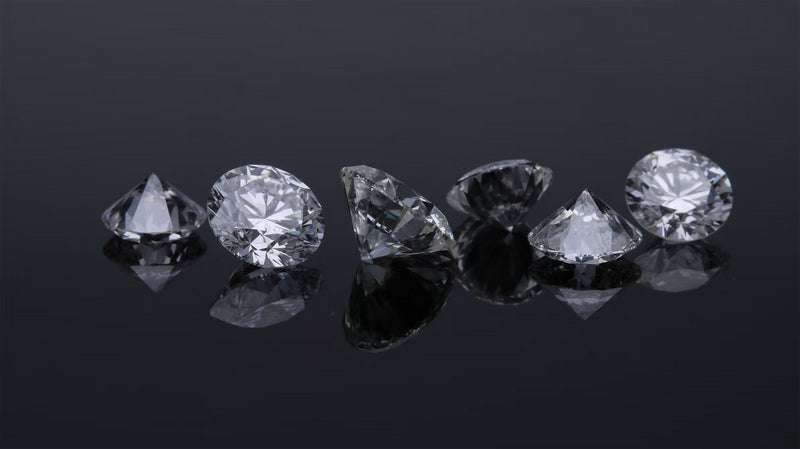
Throughout history, diamonds have been sought after for their strength, brilliance, and rarity. We’ve all heard the expression “diamonds are forever,” and while that’s certainly a catchy slogan, there’s a lot of truth behind it!
Diamond is one of the hardest and most durable substances known to man. In fact, the word “diamond” comes from the Greek word “adamas,” meaning unbreakable. Perhaps that’s why diamonds are so well-suited to engagement rings; they serve as the perfect symbol of the eternal bond shared between two people when they make the decision to spend forever together.
Continue reading to learn more about diamonds, how they’re sourced, and whether you should opt for a natural diamond or a lab-grown diamond.
Where do natural diamonds come from?
Diamond is a naturally occurring mineral composed of pure carbon, with its atoms arranged in a crystal structure called diamond cubic. The diamonds that are mined from the Earth’s surface today were formed over millions of years in the extremely high temperature and pressure conditions of the Earth’s mantle, approximately 100 miles underground. In most cases, these diamonds were brought to the Earth’s surface (encased in igneous rock) via deep-source volcanic eruptions. That’s why diamonds are typically mined from regions with a history of volcanic activity.
Currently, Russia, Botswana, the Democratic Republic of Congo, Australia, and Canada are the leading producers of natural diamonds.

Lab-created diamonds are just like natural diamonds. The only difference is that these diamonds are created in a laboratory instead of inside the Earth’s mantle.
Many people are surprised to learn that lab-grown diamonds are not a recent invention. In fact, the first man-made diamond was successfully synthesized by General Electric way back in 1954. Since then, most of the diamonds used in industrial applications have been lab-grown. However, it wasn’t until relatively recently that companies developed the technology required to successfully produce gem-quality diamonds suitable for use in fine jewelry.
Lab diamonds are created using one of two methods:
- High-pressure, high-temperature (HTHP)
- Chemical vapor decomposition (CVD)
Both processes are capable of producing stunning results. These diamonds can be grown up to 10 carats and beyond and, like natural diamonds, are available in a variety of colors.
Is there such thing as conflict-free Earth-mined diamonds?
If you’re interested in a natural diamond ring, it’s important to make sure that you purchase your diamond from a jeweler who is committed to conflict-free diamonds. Conflict-free means that the diamond did not finance civil wars.
Here at Malka Diamonds, our clients can have peace of mind knowing that all our natural diamonds are obtained through UN-approved distribution channels which adhere to the Kimberly Process (KP) Certification standards.
The KP started when Southern African diamond-producing states met in Kimberley, South Africa, in May 2000, to discuss ways to stop the trade in ‘conflict diamonds’ and ensure that diamond purchases were not financing violence by rebel movements and their allies seeking to undermine legitimate governments. Ultimately, the goal of the KP is to remove conflict diamonds from the global supply chain.
Learn more about the KP here.
Are lab diamonds real?

Yes. Lab-grown diamonds are real diamonds. They have the same chemical, physical, and visual properties as Earth-mined diamonds and they are just as dazzling. The only difference is how (and where) they are made… and you can’t tell with the naked eye whether a diamond was mined or created in a lab.
Like natural diamonds, lab diamonds come with certification (grading), which offers buyers information regarding the stone’s cut, color, clarity, and carat weight. These days, most lab diamonds are graded by the International Gemological Institute (IGI) or the Gemological Institute of America (GIA).
Are lab diamonds more ethical than natural diamonds?
Many couples opt for a lab-grown diamond over a natural diamond because they believe lab diamonds are more ethically sourced. In some cases, this may be true. However, by choosing to work with a jeweler that prioritizes ethics, transparency, and sustainability, you can feel confident buying either a lab diamond or an Earth-mined diamond.
Here at Malka Diamonds, we’re an Accredited Retailer for Sustainability Rated Diamonds. A Certified Sustainability Rated Diamond has been independently confirmed to be in full accordance with the requirements of the SCS-007 Standard — the first comprehensive, sustainability standard developed for the diamond sector.
A Sustainability Rated Diamond — whether from an accredited mined or laboratory-grown diamond operation — has been evaluated and certified against five pillars of sustainability achievement, including:
- Origin traceability
- Ethical stewardship
- Climate neutrality
- Sustainable production
- Sustainability investments
Shop for the perfect diamond ring at Portland’s finest boutique jeweler!

We love working with couples and individuals to find or create the perfect diamond ring to celebrate their love and commitment to one another. We offer both natural (Earth-mined) and lab-grown diamonds. All of our gemstones and metals are ethically sourced and our expert jewelers and GIA-certified gemologists are here to answer any and all questions you may have.
Book your in-person or virtual consultation today. We look forward to working with you!

